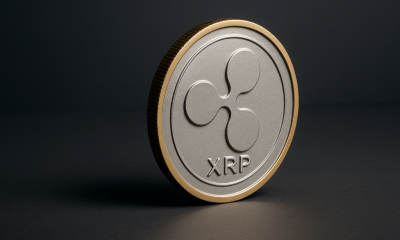

others
Australian Dollar moves downward on US Dollar recovery – Crypto News
- Australian Dollar moves downward as the US Dollar rebounds.
- Australia’s central bank is expected to raise policy rates; contributing support for the AUD.
- Chinese report revealed a decline in both manufacturing and non-manufacturing PMI for September.
- Downbeat US Treasury yields could limit the advance of the Greenback.
The Australian Dollar (AUD) halts a three-day winning streak on Tuesday. The rebound in US Dollar (USD) is weighing on the AUD/USD pair. However, the positive Australian Retail Sales contributed support for the Aussie pair ahead of the policy decision from the US Federal Reserve (Fed) on Wednesday. Moreover, the Reserve Bank of Australia (RBA) is set to release its policy decision on November 7.
Australia’s central bank is expected to raise interest rates by 25 basis points in the upcoming meeting on the back of elevated inflation. In the week before, Australia’s Consumer Price Index (CPI) revealed an expansion in the third quarter of 2023, surpassing the increase seen in the second quarter. Furthermore, the seasonally adjusted Retail Sales (Month-on-Month) pleasantly surprised the market, posting a notably higher reading in September.
The Tuesday Chinese report revealed a decline in both manufacturing and non-manufacturing Manufacturing Purchasing Managers’ Index (PMI) for September, heightening concerns about the sluggish economic conditions in the world’s second-largest economy. This development raises the possibility of an impact on the Australian Dollar, given Australia’s status as the largest trading partner of China.
The US Dollar Index (DXY) retraces recent losses before the US Fed policy decision. The moderate economic data from the United States (US) released on Friday failed to provide any support for the Greenback as the market participants expect the Fed to maintain its interest rates at 5.5% in the upcoming meeting.
However, the December’s meeting will be data-driven. As per the CME Fedwatch tools, Markets factor in a 23% probability of the Fed hiking 25 basis points (bps) in the December meeting.
Daily Digest Market Movers: Australian Dollar consolidates post recent gains ahead of Fed policy decision
Australia’s Retail Sales (Month-on-Month) soared to 0.9% in September, surpassing market expectations of 0.3% and the previous figure of 0.2%.
Australia’s Producer Price Index (PPI) exhibited a modest easing, dropping to 3.8% on a yearly basis in Q3, compared to the previous quarter’s 3.9%. On a quarterly basis, the nation’s PPI experienced a significant rise to 1.8%, up from the previous reading of 0.5%.
Australian Consumer Price Index (CPI) for the third quarter of 2023 reached 1.2%, exceeding both the 0.8% uptick in the previous quarter and the market consensus of 1.1% for the same period.
The Reserve Bank of Australia stated heightened concern about the inflation impact stemming from supply shocks. Governor of the Reserve Bank of Australia, Michele Bullock stated that if inflation persists above projections, the RBA will take responsive policy measures. There is an observable deceleration in demand, and per capita consumption is on the decline.
China’s NBS Manufacturing Purchasing Managers’ Index (PMI) took an unexpected turn in September, contracting to 49.5, down from the 50.2 expansion observed in July and falling short of the market consensus of 50.2. Additionally, the NBS Services PMI also experienced a decline, dropping to 50.6 in September compared to the anticipated figure of 51.8 and the previous reading of 51.7.
According to reports, there’s a tentative agreement between the US and China for a meeting between Presidents Joe Biden and Xi Jinping in November. This comes after months of strategic diplomatic efforts to mend relations.
US Core Personal Consumption Expenditures Price Index (YoY) saw a slight decline to 3.7% from the previous reading of 3.8%. However, the monthly index showed an increase to 0.3%, in line with expectations and up from 0.1% previously.
The University of Michigan Consumer Index surpassed expectations in October, reporting a figure of 63.8, which was expected to remain consistent at 63.0.
The market participants await the Fed Interest Rate Decision on Wednesday, expecting the interest rates to be kept at 5.5% in the upcoming meeting on Wednesday.
Investor attention will be directed towards key indicators such as the US ADP Employment Change, and ISM Manufacturing PMI for October.
Technical Analysis: Australian Dollar hovers around the key support level at 0.6350
The Australian Dollar consolidates near the significant level at 0.6350. The yearly low at 0.6270 may serve as a key support, aligned with the major level around 0.6250. Looking upward, the pivotal resistance at 0.6400 is noteworthy, accompanied by the 50-day Exponential Moving Average (EMA) at 0.6405. A successful breach above this resistance could propel the currency towards the 23.6% Fibonacci retracement level at 0.6417.
AUD/USD: Daily Chart:
Australian Dollar price today
The table below shows the percentage change of Australian Dollar (AUD) against listed major currencies today. Australian Dollar was the strongest against the Japanese Yen.
| USD | EUR | GBP | CAD | AUD | JPY | NZD | CHF | |
| USD | 0.10% | 0.12% | 0.09% | 0.14% | 0.25% | 0.10% | 0.00% | |
| EUR | -0.11% | 0.03% | 0.02% | 0.03% | 0.15% | -0.01% | -0.10% | |
| GBP | -0.13% | -0.04% | -0.02% | -0.01% | 0.11% | -0.03% | -0.13% | |
| CAD | -0.10% | 0.03% | 0.04% | 0.05% | 0.17% | 0.02% | -0.09% | |
| AUD | -0.13% | -0.02% | 0.02% | 0.00% | 0.12% | -0.03% | -0.13% | |
| JPY | -0.24% | -0.14% | -0.13% | -0.18% | -0.12% | -0.15% | -0.25% | |
| NZD | -0.09% | 0.02% | 0.06% | 0.03% | 0.03% | 0.16% | -0.11% | |
| CHF | 0.00% | 0.09% | 0.12% | 0.09% | 0.12% | 0.25% | 0.10% |
The heat map shows percentage changes of major currencies against each other. The base currency is picked from the left column, while the quote currency is picked from the top row. For example, if you pick the Euro from the left column and move along the horizontal line to the Japanese Yen, the percentage change displayed in the box will represent EUR (base)/JPY (quote).
Australian Dollar FAQs
One of the most significant factors for the Australian Dollar (AUD) is the level of interest rates set by the Reserve Bank of Australia (RBA). Because Australia is a resource-rich country another key driver is the price of its biggest export, Iron Ore. The health of the Chinese economy, its largest trading partner, is a factor, as well as inflation in Australia, its growth rate and Trade Balance. Market sentiment – whether investors are taking on more risky assets (risk-on) or seeking safe-havens (risk-off) – is also a factor, with risk-on positive for AUD.
The Reserve Bank of Australia (RBA) influences the Australian Dollar (AUD) by setting the level of interest rates that Australian banks can lend to each other. This influences the level of interest rates in the economy as a whole. The main goal of the RBA is to maintain a stable inflation rate of 2-3% by adjusting interest rates up or down. Relatively high interest rates compared to other major central banks support the AUD, and the opposite for relatively low. The RBA can also use quantitative easing and tightening to influence credit conditions, with the former AUD-negative and the latter AUD-positive.
China is Australia’s largest trading partner so the health of the Chinese economy is a major influence on the value of the Australian Dollar (AUD). When the Chinese economy is doing well it purchases more raw materials, goods and services from Australia, lifting demand for the AUD, and pushing up its value. The opposite is the case when the Chinese economy is not growing as fast as expected. Positive or negative surprises in Chinese growth data, therefore, often have a direct impact on the Australian Dollar and its pairs.
Iron Ore is Australia’s largest export, accounting for $118 billion a year according to data from 2021, with China as its primary destination. The price of Iron Ore, therefore, can be a driver of the Australian Dollar. Generally, if the price of Iron Ore rises, AUD also goes up, as aggregate demand for the currency increases. The opposite is the case if the price of Iron Ore falls. Higher Iron Ore prices also tend to result in a greater likelihood of a positive Trade Balance for Australia, which is also positive of the AUD.
The Trade Balance, which is the difference between what a country earns from its exports versus what it pays for its imports, is another factor that can influence the value of the Australian Dollar. If Australia produces highly sought after exports, then its currency will gain in value purely from the surplus demand created from foreign buyers seeking to purchase its exports versus what it spends to purchase imports. Therefore, a positive net Trade Balance strengthens the AUD, with the opposite effect if the Trade Balance is negative.
-

 others1 week ago
others1 week agoMETA stock has lower gaps to fill – Crypto News
-

 Cryptocurrency5 days ago
Cryptocurrency5 days agoAndrew Tate Buys $5 Million Worth of Bitcoin Hours Before Crash – Crypto News
-

 Cryptocurrency5 days ago
Cryptocurrency5 days agoBitcoin tests $100K support after massive liquidation event rocks market – Crypto News
-
Cryptocurrency1 week ago
After 1,993% Burn Spike, Is Shiba Inu Price Set for a Major Trend Reversal? – Crypto News
-

 Cryptocurrency4 days ago
Cryptocurrency4 days agoMany Crypto Treasury Companies Were a Get-Rich-Quick Trap, Warns Columbia Professor – Crypto News
-

 Cryptocurrency5 days ago
Cryptocurrency5 days agoAndrew Tate Buys $5 Million Worth of Bitcoin Hours Before Crash – Crypto News
-

 Cryptocurrency4 days ago
Cryptocurrency4 days agoStrategy IPO redefines corporate Bitcoin strategy with euro-denominated offering – Crypto News
-

 Blockchain1 week ago
Blockchain1 week agoSmart Money Buys the Dip – Crypto News
-

 Metaverse1 week ago
Metaverse1 week agoAI boom is just beginning – Nvidia CEO Jensen Huang explains what’s driving the virtuous cycle – Crypto News
-

 Cryptocurrency1 week ago
Cryptocurrency1 week agoZIGChain eyes gains as Nasdaq-Listed SEGG Media backs ZIG – Crypto News
-

 Cryptocurrency5 days ago
Cryptocurrency5 days agoLitecoin: $855K ETF inflow sparks new life – Next target is $105 IF… – Crypto News
-
others6 days ago
“Never Had Plans to Sue Binance,” Wintermute CEO Evgeny Gaevoy Confirms – Crypto News
-
Business1 week ago
Not L1s or Wallets – Who Generates the Bulk of Crypto’s $20B in Revenue? – Crypto News
-

 Blockchain1 week ago
Blockchain1 week agoBasel Reportedly Aims for Friendlier Crypto Bank Guidelines – Crypto News
-

 Cryptocurrency1 week ago
Cryptocurrency1 week agoHBAR under pressure, Descending channel hints at 24% downside move – Crypto News
-

 Cryptocurrency6 days ago
Cryptocurrency6 days agoRipple Just Made XRP and RLUSD Tradeable Like Stocks: Here’s How – Crypto News
-

 Blockchain6 days ago
Blockchain6 days agoStablecoin Orchestration Becomes FinTech Battleground – Crypto News
-

 Cryptocurrency4 days ago
Cryptocurrency4 days agoBittensor (TAO) plunges 16% amid broader crypto sell-off – Crypto News
-

 Blockchain1 week ago
Blockchain1 week agoXRP Chart Mirrors Gold Right Before Its Parabolic Run – Crypto News
-

 others1 week ago
others1 week agoGBP/USD tests six months lows as Pound Sterling continues to sink – Crypto News
-
Technology1 week ago
XRP Price Outlook as ETF Nears Possible November 13 Launch – Crypto News
-

 Cryptocurrency1 week ago
Cryptocurrency1 week agoIs the Market Finally Learning to Handle Volatility? – Crypto News
-
others1 week ago
Russia S&P Global Manufacturing PMI dipped from previous 48.2 to 48 in October – Crypto News
-

 Metaverse1 week ago
Metaverse1 week agoPerplexity AI CEO Aravind Srinivas touts new feature revealing Indian politicians’ stock holdings—How will it work? – Crypto News
-
others1 week ago
Pi Coin Price Prediction After AI Investment Announcement – Is a Bull Run Ahead? – Crypto News
-

 Blockchain1 week ago
Blockchain1 week agoChainlink Maintains Its Base, But One Push Could Flip Sentiment Fast – Crypto News
-

 Blockchain6 days ago
Blockchain6 days agoTokenized Treasuries cross $8.6B as banks and exchanges push collateral use – Crypto News
-
Technology1 week ago
Canary XRP ETF Filing Removes SEC Delay Clause, Targets November Launch – Crypto News
-

 Cryptocurrency1 week ago
Cryptocurrency1 week agoOndo Finance launches 100+ tokenized assets on BSC – Here’s why it matters – Crypto News
-

 De-fi1 week ago
De-fi1 week agoFourMeme Surpasses Pumpfun With $43 Million in Monthly Revenue – Crypto News
-

 Technology1 week ago
Technology1 week agoGHOST extends rally as whale scoops 4.8 million tokens – Crypto News
-

 Technology1 week ago
Technology1 week agoCities Deploy Robots as Firefighters, Tour Guides and Lawnmowers – Crypto News
-

 others1 week ago
others1 week agoGBP/USD hits seven-month low as UK fiscal woes, Fed hawkishness weigh – Crypto News
-

 Blockchain1 week ago
Blockchain1 week agoBitcoin In IPO Phase As Early Holders Give Way to New Investors – Crypto News
-
Cryptocurrency6 days ago
Crypto Market Crash as $595.8M in Longs is Liquidated, Bitcoin Slides to $105,000 – Crypto News
-

 Cryptocurrency5 days ago
Cryptocurrency5 days agoGold declined but still outperformed BTC last week – Crypto News
-

 Cryptocurrency5 days ago
Cryptocurrency5 days agoPi Network (PI) News Today: November 4th – Crypto News
-

 Blockchain5 days ago
Blockchain5 days agoChainalysis Warns of ‘Concerning’ Vulnerabilities in DeFi Platforms – Crypto News
-
others5 days ago
AI Bubble: Big Short Legend Michael Burry Bets Against AI Giants As NVIDIA And Palantir Stocks Dip – Crypto News
-
Cryptocurrency5 days ago
Dogecoin Price Risks 20% Crash as Death Cross Aligns With Falling DOGE ETF Inflows – Crypto News
-

 Blockchain1 week ago
Blockchain1 week agoJPMorgan Uses In-House Blockchain to Tokenize PE Fund – Crypto News
-
others1 week ago
Senate Committee Finalizes Updated Crypto Market Structure Bill Draft, Release Expected In Days – Crypto News
-

 Blockchain1 week ago
Blockchain1 week agoQuantum Computing Still Years from Threatening Bitcoin, Says VC Amit Mehra – Crypto News
-

 Metaverse1 week ago
Metaverse1 week agoGo from idea to app in minutes with Google AI Studio – Crypto News
-
Technology1 week ago
Why Is TAO Price Skyrocketing Today? – Crypto News
-

 Metaverse1 week ago
Metaverse1 week agoDoes Nvidia’s $5-trillion feat raise the spectre of an AI winter? – Crypto News
-

 Blockchain1 week ago
Blockchain1 week agoWill Bitcoin’s Latest Sunday Pump be Different This Time? – Crypto News
-

 Metaverse4 days ago
Metaverse4 days agoPaytm is getting AI! Vijay Shekhar Sharma drops cryptic teaser ahead of launch – Crypto News
-

 Blockchain1 week ago
Blockchain1 week agoBlockchain Onchain Revenue Nears $20B in 2025 – Crypto News
-

 Blockchain1 week ago
Blockchain1 week agoHow To Price XRP? Ripple CTO Says The Ledger Isn’t The Answer – Crypto News




